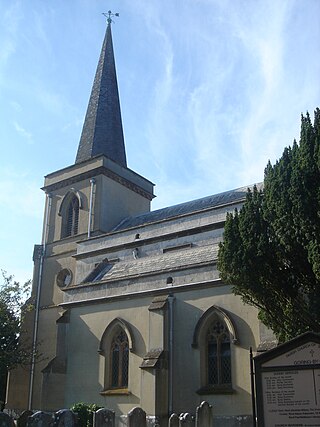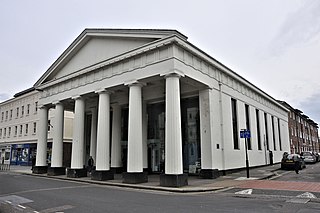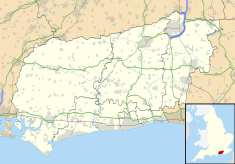
Chichester is a cathedral city and civil parish in West Sussex, England. It is the only city in West Sussex and is its county town. It was a Roman and Anglo-Saxon settlement and a major market town from those times through Norman and medieval times to the present day. It is the seat of the Church of England Diocese of Chichester, with a 12th-century cathedral.

The Church of Saint Bridget is in Bagot Street, Wavertree, Liverpool, Merseyside, England. It is recorded in the National Heritage List for England as a designated Grade II* listed building, and is an active Anglican parish church in the diocese of Liverpool, the archdeaconry of Liverpool and the deanery of Toxteth and Wavertree.

St Margaret's Church is an Anglican church in the Ifield neighbourhood of Crawley, a town and borough in West Sussex, England. It is the ancient parish church of the village of Ifield; the medieval settlement was expanded to form one of the New Town of Crawley's 13 neighbourhoods, and the church's modern parish now serves several other neighbourhoods as well.

Malmesbury Market Cross is a Grade I listed, late 15th century structure in the town of Malmesbury, Wiltshire, England.

St Mary's Church is an Anglican church in the Kemptown area of Brighton, in the English city of Brighton and Hove. The present building dates from the late 1870s and replaced a church of the same name which suddenly collapsed while being renovated. The Gothic-style red-brick building, whose style resembles Early English revival and French Gothic revival, is now a Grade II* listed building, and remains in use despite threats of closure.

St Peter's Church is a former Anglican church in the Preston Village area of Brighton, in the English city of Brighton and Hove. The 13th-century building, standing on the site of two older churches, was restored in the late 19th century and again after a serious fire in 1906. It was the parish church of Preston until 1908, when the newly built St John the Evangelist's Church gained this status. The Diocese of Chichester declared St Peter's redundant in 1990, and it is now owned by the Churches Conservation Trust. It has Grade II* listed status, reflecting its architectural and historical importance.

Lewes Free Presbyterian Church, based in the Jireh Chapel, is one of seven Free Presbyterian Church of Ulster places of worship in England. The Jireh Chapel is a former Calvinistic Independent chapel in the Cliffe area of Lewes, the county town of East Sussex and the main town in the local government district of Lewes. It is more than 200 years old and has been designated a Grade I Listed building.

St Mary's Church is an Anglican church in the Goring-by-Sea area of the Borough of Worthing, one of seven local government districts in the English county of West Sussex. The late Norman parish church of the ancient village of Goring retains some architectural elements from that period, but Decimus Burton's comprehensive restoration of 1837 has given the church its present Gothic Revival exterior appearance. German artist Hans Feibusch, who worked extensively in the Diocese of Chichester, provided a mural in 1954: it is considered impressive, but caused controversy at the time. English Heritage has listed the church at Grade II* for its architectural and historical importance.

Holy Trinity Church is an Anglican church in the centre of Hastings, a town and borough in the English county of East Sussex. It was built during the 1850s—a period when Hastings was growing rapidly as a seaside resort—by prolific and eccentric architect Samuel Sanders Teulon, who was "chief among the rogue architects of the mid-Victorian Gothic Revival". The Decorated/Early English-style church is distinguished by its opulently decorated interior and its layout on a difficult town-centre site, chosen after another location was found to be unsuitable. The church took eight years to build, and a planned tower was never added. English Heritage has listed the building at Grade II* for its architectural and historical importance.

Malmesbury is a town and civil parish in north Wiltshire, England, which lies approximately 14 miles (23 km) west of Swindon, 25 miles (40 km) northeast of Bristol, and 9 miles (14 km) north of Chippenham. The older part of the town is on a hilltop which is almost surrounded by the upper waters of the Bristol Avon and one of its tributaries.

Carlton Hill is an inner-city area of Brighton, part of the English city and seaside resort of Brighton and Hove. First developed in the early and mid-19th century on steeply sloping farmland east of central Brighton, it grew rapidly as the town became a fashionable, high-class destination. Carlton Hill's population was always poor, though, and by the early 20th century the area was Brighton's worst slum: overcrowding, crime and disease were rife. Extensive slum clearance in the mid-20th century introduced high-density tower blocks, but some old buildings remain: in 2008, Brighton and Hove City Council designated part of Carlton Hill as the city's 34th conservation area. The area now has housing of various styles and ages, large offices and small-scale industry; there are also churches, a school and some open space.

All Saints Church is the Anglican parish church of Roffey, in the Horsham district of the English county of West Sussex. The present church, built to serve the Victorian suburb of Roffey—part of the ancient market town of Horsham—replaced a schoolroom in which religious services had been held since 1856. Arthur Blomfield's Early English-style church, built of locally quarried sandstone and funded by a widow as a memorial to her late husband, was completed in 1878 and was allocated a parish immediately. Roman Catholic services were also held in the building to serve Roffey's Catholic population, but these ceased in the early 21st century. English Heritage has listed the church at Grade II for its architectural and historical importance.

The Novium is a museum in Chichester, West Sussex, southern England. The name comes from the Roman name for the city, Noviomagus Reginorum.

St John the Evangelist's Church is a redundant Anglican church in the cathedral city of Chichester in West Sussex, England. Built in 1812 to the design of James Elmes as a proprietary chapel, the octagonal white-brick "evangelical preaching house" reflects the early 19th-century ideals of the Church of England's evangelical wing before High church movements such as the Cambridge Camden Society changed ideas on church design. The Diocese of Chichester declared it redundant in 1973. Although worship no longer takes place in the building, its theatre-like design has made it a popular venue for concerts and musical events. The church is a Grade I Listed building.

The Winchester College War Cloister is a war memorial at Winchester College, in Hampshire, designed by the architect Sir Herbert Baker. The roofed quadrangle is said by Historic England to be the largest known private war memorial in Europe. It became a Grade II listed building in 1950, and was upgraded to Grade I in 2017, as one of 24 war memorials in England designed by Baker that were designated by Historic England as a national collection.

St Peter's Church is a Church of England parish church in the large village of Henfield, West Sussex. Placed on the site of an 8th-century Saxon church also dedicated to St Peter, it was built in the 13th, 14th and 15th centuries, but was heavily restored and partially rebuilt in the 19th century. English Heritage has listed it at Grade II* for its architectural and historical importance. Services for the parish continue and also cover the parishes of St Giles', Shermanbury and St. Peter's, Woodmancote, which form its united benefice.

Corn exchanges are distinct buildings which were originally created as a venue for corn merchants to meet and arrange pricing with farmers for the sale of wheat, barley, and other corn crops. The word "corn" in British English denotes all cereal grains, such as wheat and barley. With the repeal of the Corn Laws in 1846, a large number of corn exchanges were built in England, particularly in the corn-growing areas of Eastern England.

Edes House is mansion in Chichester, West Sussex. The building, which was the headquarters of West Sussex County Council from 1916 to 1936, is a Grade I listed building.

The Corn Exchange is a Grade II* listed building in Chichester, West Sussex, England. Built in 1833, the building has also been used as a Granada cinema. It is currently leased to a number of companies, including Next and the Boston Tea Party café chain.

The Market Cross in Oakham, Rutland, England, is a market cross dating from the 16th or 17th century. Market crosses, also termed butter crosses, may derive from the high crosses or free-standing stones of the Early Mediaeval period. In the Middle Ages they were often used as gathering points in the centres of communities, generally as venues for regular markets. Beneath the cross is a set of stocks. Both are Grade I listed structures and the group forms a Scheduled monument.






















